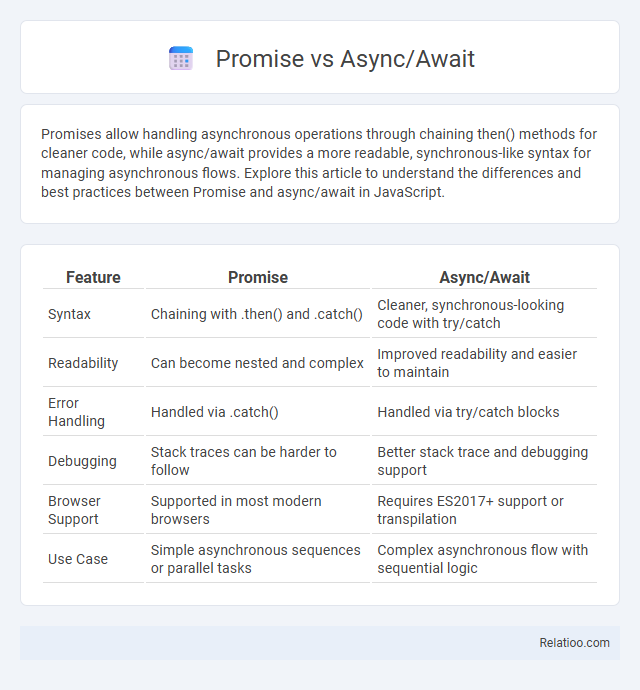Promises allow handling asynchronous operations through chaining then() methods for cleaner code, while async/await provides a more readable, synchronous-like syntax for managing asynchronous flows. Explore this article to understand the differences and best practices between Promise and async/await in JavaScript.
Table of Comparison
| Feature | Promise | Async/Await |
|---|---|---|
| Syntax | Chaining with .then() and .catch() | Cleaner, synchronous-looking code with try/catch |
| Readability | Can become nested and complex | Improved readability and easier to maintain |
| Error Handling | Handled via .catch() | Handled via try/catch blocks |
| Debugging | Stack traces can be harder to follow | Better stack trace and debugging support |
| Browser Support | Supported in most modern browsers | Requires ES2017+ support or transpilation |
| Use Case | Simple asynchronous sequences or parallel tasks | Complex asynchronous flow with sequential logic |
Introduction to Asynchronous JavaScript
Asynchronous JavaScript enables your code to handle time-consuming tasks without blocking the main thread, improving application performance and user experience. Promises represent eventual completion or failure of an asynchronous operation, providing a cleaner alternative to callbacks. Async/await syntax builds on Promises, allowing you to write asynchronous code that appears synchronous, enhancing readability and maintainability.
What Are Promises?
Promises are JavaScript objects representing the eventual completion or failure of an asynchronous operation, allowing you to write cleaner, more manageable code. They help handle asynchronous tasks by providing methods like .then() and .catch() to process success or error outcomes without deeply nested callbacks. Understanding promises is essential for mastering async/await syntax, which builds on promises to simplify asynchronous code readability and flow control.
Understanding Async/Await
Async/Await simplifies asynchronous code by allowing developers to write it in a synchronous style, improving readability and maintainability compared to using Promises directly. It is built on top of Promises, enabling easier chaining and error handling through try/catch blocks rather than then/catch methods. Understanding Async/Await is crucial for effective JavaScript programming as it streamlines complex asynchronous flows while preserving the benefits of Promises.
Syntax Comparison: Promises vs Async/Await
Promises use then() and catch() methods to handle asynchronous operations, resulting in nested chains for sequential tasks. Async/await syntax enables writing asynchronous code that resembles synchronous flow by using the await keyword inside async functions, improving readability and reducing callback complexity. Unlike Promises, async/await automatically handles promise resolution and rejection with try/catch blocks for error management.
Error Handling: Then/Catch vs Try/Catch
Error handling in Promises typically involves the .then() method paired with .catch() to manage rejected promises, ensuring errors are captured in the promise chain. Async/Await enhances readability by using try/catch blocks, allowing synchronous-style error management within asynchronous functions. Your choice impacts code clarity and debugging ease, with try/catch often preferred for clearer, more maintainable error handling in modern JavaScript development.
Readability and Code Maintainability
Async/await improves readability by allowing asynchronous code to be written in a synchronous style, reducing nested callbacks and making error handling straightforward using try/catch blocks. Promises offer better maintainability than traditional callbacks due to their chaining capabilities but can become complex when handling multiple asynchronous operations, leading to less readable "promise hell." Your code will be easier to maintain and debug when using async/await, especially in complex scenarios, because it simplifies flow control and clearly expresses the intended sequence of operations.
Chaining and Composition Differences
Promise chaining uses `.then()` methods to handle asynchronous steps sequentially, allowing results to be passed from one promise to the next, but can become complex with deeply nested chains. Async/await provides a cleaner, more readable syntax for composing promises by allowing you to write asynchronous code that looks synchronous, improving error handling and flow control in your code. Your choice between these depends on whether you prioritize explicit, step-by-step promise chaining or a more straightforward, linear async code structure with async/await.
Performance Considerations
Async/Await syntax simplifies asynchronous code management but introduces slight overhead compared to raw Promises due to the underlying state machine it creates, potentially affecting performance in tight loops. Promises offer more fine-grained control over execution flow with marginally better performance benchmarks, especially in scenarios demanding rapid, numerous concurrent operations. Evaluating performance should consider the specific use case, as Async/Await enhances readability and maintainability despite minor latency trade-offs in execution speed.
Real-World Use Cases
Promise, Async/Await, and callback functions each serve specific real-world use cases in JavaScript asynchronous programming. Promises are ideal for chaining multiple asynchronous operations and handling errors cleanly, especially in API requests or file operations. Async/Await offers more readable syntax for asynchronous code, making it easier for you to write and maintain complex workflows like database queries or user authentication systems.
Choosing Between Promises and Async/Await
Choosing between Promises and Async/Await hinges on code readability and error handling preferences; Async/Await offers a more synchronous-looking syntax that simplifies chaining and debugging asynchronous code. Promises provide more control with methods like .then() and .catch(), suitable for complex promise chains and parallel operations. For cleaner, more maintainable code in most modern JavaScript applications, Async/Await is often the preferred choice.

Infographic: Promise vs Async/Await
 relatioo.com
relatioo.com